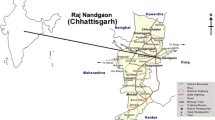Abstract
The concentrations of water soluble ions (Na+, NH4 +, K+, Mg2+, Ca2+, NO3 -, Cl-, and SO 2-4 ) in PM10 samples collected on cellulose filters by a medium-volume cascade impactor were determined, which were obtained from three kinds of areas in Chongqing: industrial area (Jiulongpo district), commercial and residential area (Jiangbei district) and background area (Jinyun Mountain in the Beibei district). The results showed that except for the background site, the annual average values of PM10 are 23% – 61% higher than the national air quality standard (GradeII) (0.1 mg/m3), even that the value of the control site is still 20% higher than American standard (0.05 mg/m3). This implied that serious pollution of fine particles occurred in Chongqing. Nine kinds of soluble ions in water of PM10 were analyzed by ion chromatography (IC) and the annual average concentrations follow the order of [SO 2-4 ] > [NO3 -] > [Cl-] > [F-], and [Ca2+] > [NH4 +] > [K+] > [Na+] > [Mg2+]. Their values were different in these areas: the industrial area > the commercial and living area > the control area. As for NH4 +, K+, Ca2+, NO3 - and SO 2-4 , their seasonal average concentrations show a similar variation trend: the values in spring and fall were higher than those in summer and winter. The seasonal average concentrations of [Cl-], [F-], [Na+] and [Mg2+] are much lower than those of other ions. However, the concentrations of [Na+] changed more greatly in different seasons than those of the other three ions. Correlation coefficients showed that the three areas have been polluted by coal smoke and dust to different extents, while some local resources of pollution should be taken into consideration as well.
Similar content being viewed by others
References
Cao Shouren (1992) The chemical composition of fine dust in atmospheric environment [J].Health Study.15, 199.
Chapman R. S., Watkinson W. P., Dreher K. L. et al. (1977) Ambient paniculate matter and respiratory and cardiovascular illness in adults: particle-born transition metals and the heart-lung axis [J].Environmental Toxicology and Pharmacology.4, 331–338.
Horvath H. (1993) Atmospheric light absorption; a review [J].Atmospheric Environment.27A, 293–317.
Matusmoto K. and Tanake II. (1996) Formation and dissociation of atmospheric particulate nitrate and chloride, and approach based on phase equilibrium [J].Atmospheric Environment.30, 639.
Willeke K. and Baron P. A. (1993)Aerosol Measurement; Principles, Techniques and Applications [M]. pp. 249. Van Nostrand Reinhold, New York.
Wu Dui (1990)Initial Study on Distribution of Mass Band of Atmospheric Aerosol and Band of Water-Soluble Components in Southern China [C]. pp. 159. Paper Collections of the Third Session of the National Aerosol Workshop, Yantai (in Chinese).
Author information
Authors and Affiliations
Rights and permissions
About this article
Cite this article
Qingquan, L., Xuefu, X., Gangcai, C. et al. Water soluble components of PM10 in Chongqing, China. Chin. J. Geochem. 24, 155–157 (2005). https://doi.org/10.1007/BF02841159
Issue Date:
DOI: https://doi.org/10.1007/BF02841159




